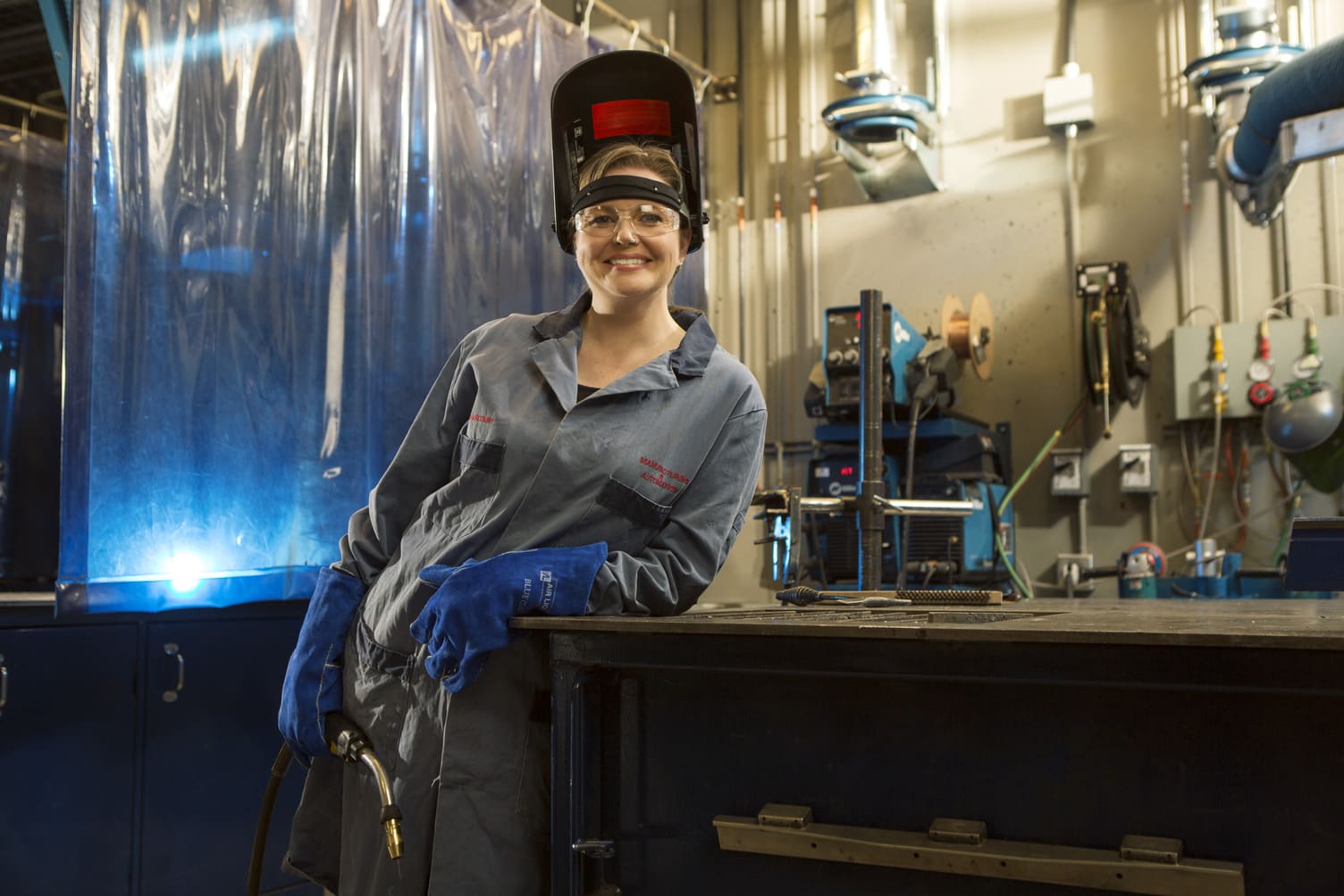On this page:
Overview
Learn to service and operate the hoist and swing equipment used to move machinery, materials and other large objects.
If you like to work independently and are a capable decision-maker, you'll enjoy a career as a mobile crane operator. You'll set up, service and operate hydraulic booms mounted on turrets that are affixed to trucks and are capable of moving heavy loads.
Certification is required when operating:
- booms (including telescoping booms and articulating booms possessing live lines) capable of swinging, hoisting and booming up and down with a lifting capacity of greater than five tons (4.5 tonnes) and equal to or less than 65 tons (59 tonnes)
- articulating booms without live lines with a lifting capacity of greater than eight tons (7.3 tonnes) and equal to or less than 65 tons (59 tonnes).
As an operator, you'll manipulate several pedals and levers to rotate the crane. You'll also raise and lower loads. You may perform all or some of these operations simultaneously.
To work in this trade, certification is required. This means that you must either be a registered apprentice who is working under the guidance of a certified journeyperson or you must be a certified journeyperson yourself.
To be successful in this trade, you should:
- have good coordination and manual dexterity
- be comfortable working at heights
- have strength, stamina and the ability to use proper lifting techniques
- have good vision
- be able to work as part of a team and communicate with ground crews, usually using hand signals and voice communication
- be comfortable working outside in a variety of weather conditions.
Upon successfully completing the required working hours and technical training periods, you'll be awarded journeyperson status by Alberta’s Apprenticeship and Industry Training.
Careers and opportunities
Our graduates may work in the following occupations. Some careers require additional experience and education.
Associated National Occupational Classification (NOC) codes: 14400, 14405, 70020, 72024, 72500, 73400, 75110.
Apprenticeship training
The term of apprenticeship for a boom truck operator is one year (one 12-month period), including a minimum of 1200 hours of on-the-job training and six weeks of apprenticeship education subject to the training institutes.
Year 1 | Period 1
You'll learn about workplace safety, materials and tools. You’ll also experience an introduction to boom trucks and cranes, codes and documentation, rigging equipment and procedures, load chart reading and interpretation, equipment operations as well as specialty lifts and workplace coaching.
Hands-on experience will be gained in our simulator lab and using real equipment.
Training length: 6 weeks
Apprenticeship education performance
You must pass each section of the course and the AIT exam to succeed in apprenticeship education.
The passing grade for each period is no less than 50% in each course, with no less than a 65% average overall. A passing mark on each provincial exam and the interprovincial qualification (Red Seal Exam) is 70%.
View Alberta's Apprenticeship and Industry Training procedures
Training pathways
You can earn your journeyperson designation in the following way.
The traditional training pathway begins with finding a job with an employer willing to indenture you as an apprentice. Once you are an apprentice, you will alternate between on-the-job training and educational periods.
You must apply for an apprenticeship through Alberta Apprenticeship and Industry Training before attending your first education period at SAIT.
Admission requirements
To enter an apprenticeship, you must have the educational qualifications required or recommended education for the trade to which you apply.
Entrance requirements are monitored and set by Alberta Apprenticeship and Industry Training.
Minimum requirements
Successful completion of the following courses:
- English 10-2
- Math 10-3
OR
A pass mark in all five Canadian General Educational Development (GED) tests
OR
Alberta Apprenticeship and Industry Training entrance exam.
Recommended requirements
Apprentices with an Alberta High School Diploma that includes the following courses:
- English 30-2
- Math 30-3
- Physics 20 OR Chemistry 20 OR Science 20
- Related career and technology studies (CTS) courses

MyTradeSecrets
Once you have begun working as an apprentice, you can attend SAIT to complete your technical training.
You'll register for technical training at SAIT on MyTradeSecrets or you can register by phone.
Transfer agreements
At SAIT, we evaluate post-secondary credit you have previously earned and apply it to your SAIT credential. Explore our formal transfer agreements available for this program.
We can evaluate your prior education, even if we don't have a formal agreement in place.
Submit a transfer credit application
There are no formal transfer agreements currently in place for this program.
Transfer options for graduates
Build on the knowledge you’ve learned at SAIT. The opportunity to advance your education at an accredited post-secondary institution may be available.
🔗 Visit Transfer Alberta search tool for all transfer agreements in Alberta (including UCalgary, MRU and BVC).
If there are transfer agreements with other institutions outside of Alberta, nationally or internationally, they will be listed below.
Available intakes
Costs
2025/26 tuition and fees
The following costs are effective as of July 1, 2025.
| Period | Number of weeks | Tuition fees | Additional fees |
Total |
|---|---|---|---|---|
| 1 | 6 | $900 | $320.16 | $1,220.16 |
|
Total cost:
|
$1,220.16 | |||
This is a bring-your-own-device program with a standard computer hardware and software requirement. See the specific requirements on our computers and laptops page.
Books or modules, along with other items for classes, are approximately $450.
We recommend you don't purchase books or modules ahead of time as they might be outdated by the time you attend classes, and they cannot be returned to the Bookstore.
You'll purchase your books and supplies at SAIT’s Point Trotter campus.

Funding options for apprentices
Apprentices get to learn while they earn, but there are still costs to consider. Many resources are available at SAIT and federally to help support apprentices.
Information sessions
Prepare for a strong start in your chosen program or get the details you need to decide your future path.
Our expert staff and faculty are ready to answer your questions and provide information about the following:
- What sets SAIT apart
- An introduction to the program and area of study
- Admission requirements
- Future career paths
- Information on the earning potential and graduate employment rates.
Contact
Have more questions?
Apprenticeship training and registration
Apprenticeship and Industry Training Client Services

Oki, Âba wathtech, Danit'ada, Tawnshi, Hello.
SAIT is located on the traditional territories of the Niitsitapi (Blackfoot) and the people of Treaty 7 which includes the Siksika, the Piikani, the Kainai, the Tsuut’ina and the Îyârhe Nakoda of Bearspaw, Chiniki and Goodstoney.
We are situated in an area the Blackfoot tribes traditionally called Moh’kinsstis, where the Bow River meets the Elbow River. We now call it the city of Calgary, which is also home to the Métis Nation of Alberta.
